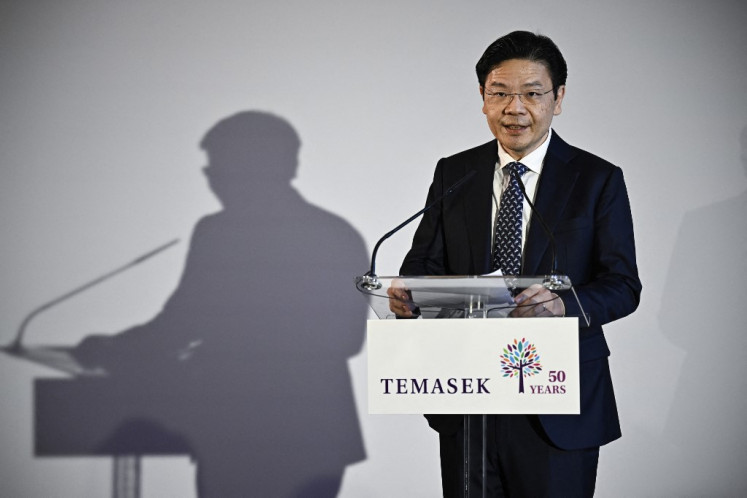Leadership changes and the future of East Asia
What will East Asia look like in 10 years time after the upcoming, and recent, changes in the leadership of some countries? What are the emerging economic and political orders? Obviously, we donât know, but we can make an informed guess on how the world might change and how Asia might transform on the basis of reviewing major trends and potential game changers
Change Size

W
hat will East Asia look like in 10 years time after the upcoming, and recent, changes in the leadership of some countries? What are the emerging economic and political orders? Obviously, we don't know, but we can make an informed guess on how the world might change and how Asia might transform on the basis of reviewing major trends and potential game changers.
A few months ago I read an interesting take on the two tales of Asia. The first tale is about 'economic Asia', which is a dynamic, increasingly integrated, rising and successful region.
The other tale is about 'security Asia', which is a dysfunctional region with rising nationalism, escalating territorial disputes and distrust among the key players.
The question this piece of writing centers on is whether security Asia in the next few years would destroy economic Asia, thus, Asia is actually heading toward a profound crisis.
There are obviously different viewpoints, about how these two tales of Asia would reconcile. In a way, these different perspectives reflect our assumptions on how Asian countries will respond to the dynamics of these two different Asias, and how they will manage this Asian paradox.
One important factor is the relationship between the US and China as the two dominant players shaping security in Asia.
The US is the largest economy in the world, a resident and predominant Pacific power since World War II, and it is determined to remain there, through its rebalancing policy toward Asia.
China is the second largest world economy, a rising Asian power, determined to build up its armed forces to enhance security and to support its rightful place in the evolving world order.
If their rivalry escalates, countries in Asia could drift into bipolarity and indeed the dynamics of economic development in the region would be affected.
In an ideal world, Asian countries would learn to accommodate China's rising and China would learn to address its neighbors' concerns, at the same time, all parties involved in territorial disputes would exercise restraint and pragmatism.
Further, the climate of peace and stability in Asia would remain positive to enable Asia to continue to focus on economic development and the tale of the two Asias would not end in a tragedy; instead the center of the world's gravity would continue to shift toward Asia.
President Xi Jinping said China wants a stable and constructive relationship with the US insofar as the two countries have enormous shared interest.
Under President Xi's leadership, Beijing seems to be on the same page as Seoul and Washington regarding how to handle North Korea. President Xi has put denuclearization of Korean Peninsula as a matter of priority.
In his inauguration speech, he said that his focus in the next few years would be on achieving the dream of a great renaissance of China.
He also said that China would focus on addressing domestic challenges such as declining growth rates, growing inequality, governance issues, corruption and the environment to ensure China continues to modernize.
It is possible that at the California Summit next week, President Xi and President Barack Obama would try to define a new model of relations between an established power and an emerging power.
In Japan, Prime Minister Shinzo Abe adopted the Clinton era slogan 'it's the economy, stupid'. He engineered the selection of a new governor of the Bank of Japan who would back his plan to induce the inflation target of 2 percent, which would then bring down the value of the Japanese yen.
During his visit to Washington DC, he announced that 'Japan is back' underscoring his commitment to economic revival, and to a leadership role in global affairs.
Unfortunately, some of his recent remarks about history and nationalistic sentiment have led to increasing tension and greater distrust in Japan's neighboring countries, even though those comments might just be rhetorical ahead of the upper house elections in July.
President Park Geun Hye took Pyongyang, North Korea, by surprise with decisive action on Kaesong where she ordered South Korean workers to pack up and leave. Currently, her approval rating is even stronger than the period leading up to her election victory.
Her recent trip to the US was outstandingly successful not only in terms of strengthening the alliance with the US, but also in terms of demonstrating Korea's position as a middle power player to contribute to the future shape of the region.
In Southeast Asia, ASEAN solidarity has gone through different tests on a number of events.
Nevertheless, ASEAN continues to make progress in the building of the ASEAN Economic Community by 2015 with a combined population larger than Western Europe and a combined gross domestic product (GDP) of around US$3 trillion.
In general, ASEAN is in favor of the US taking an active and constructive interest in Asia. While territorial disputes between some countries in Southeast Asia and China have generated uneasiness and suspicion about Beijing's ambitions and assertiveness, ASEAN as a group believes that the new leadership in China would take a pragmatic approach to addressing the concerns of its neighbors.
So in a sense, countries in East Asia are at a crossroads where they have to choose between the path of confrontation and the path of economic cooperation, which requires a climate of peace and stability. Obviously, apart from security related issues, in the economic area, there are critical risks that Asian countries have to deal with.
In light of the uncertainties surrounding the eurozone, slow and jobless recovery in other advanced nations, slowing down in China's economy, threat of major currency devaluation leading to currency
war, there could be increasing political pressures for governments around the world to introduce protectionist measures.
If indeed, more and more countries are resorting to policy measures to protect jobs and the domestic market, the impact of this 'trade war' on the future growth of Asia would be substantial.
Furthermore, East Asia must also embrace for possible financial shocks, which would follow
when the US and other advanced economies stop monetary easing, thus, creating a possible massive reversal of capital flows and the bursting of asset bubbles in some Asian economies.
Despite the political and economic risks that need to be addressed, Asia's future remains a promising one. The task now is for all the Asian leaders to continue to focus on crafting the climate and conditions that will propel the region toward continued development, progress and prosperity.
The writer is ambassador of Indonesia to South Korea. He will attend the Jeju Forum diplomat's roundtable on May 31.









